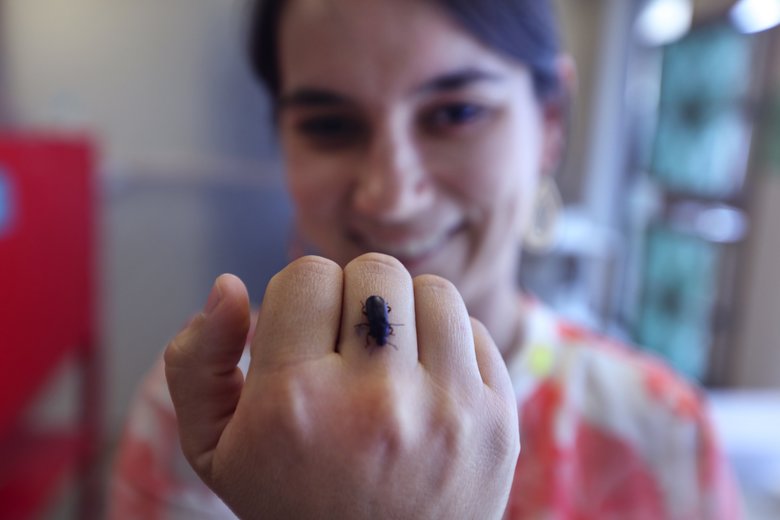By Kara Carlson
The Seattle Times
WWR Article Summary (tl;dr) The idea of eating insects might seem gross, but it may not be far off. With increasing world population, some scientists and entrepreneurs are looking to insects because they have less need for space and water.
The Seattle Times
The Seattle area’s only commercial insect farm is home to tens of millions of wriggling creatures at various stages of development. Walls of heavy plastic sheeting and stacked trays help keep organized the insects that call it home, but with an average size at just over an inch per occupant, there’s plenty of room to spare.
Virginia Emery, a Ph.D. and self-proclaimed insect entrepreneur, spends her days rearing these teeming masses of mealworms. Her company, Beta Hatch, ultimately hopes to convince people to think of insects as an undeveloped protein source, although for now the business is selling them as feed for livestock and fish.
But Beta Hatch does have a product for the home consumer, too: It is packaging their poop, or frass, for fertilizer. PCC Natural Markets sells 2.5-ounce bags for $3.29 and 20-ounce ones for $11.69.
To date the startup has raised $1.2 million from local investors and grant funding.
Emery, whose doctorate in entomology is from the University of California, Berkeley, has a passion for business and started the company in 2015.
And she’s not alone.
“Right now. there’s a wave of insect industry,” Emery said.
She believes she’s the only one farming insects in the state so far, but there are others in the U.S. and around the world.
Agriprotein, a South African farming company that sells Magmeal (maggots) for livestock consumption, attracted the eye of Microsoft co-founder Bill Gates, as well as his financial backing.
Tiny Farms in California raises crickets for human consumption. Crickets are popular (in some circles) for grinding up into flour. One startup, Exo sells cricket protein bars.
The idea of eating insects might seem gross, but it may not be far off. With increasing world population, some scientists and entrepreneurs are looking to insects because they have less need for space and water.
For now, Emery is only focused on raising insects for livestock — she knows most people aren’t yet ready to eat them.
From her perspective, growing mealworms as a protein feed source is simple common sense. Chickens and fish eat insects naturally in the wild, and mealworms offer a more eco-friendly and sustainable option than fish meal. When scaled up, she thinks, mealworms will also be more cost efficient than other feeds.
Currently many fish farms use fish meal, which means smaller wild fish must be caught for feed. These smaller fish are only available for part of the year, and the practice can cause overfishing, disrupt ecosystems and drive up prices.
Mealworms are especially sustainable because unlike other farmed insects like crickets, mealworms can be grown dry, taking the moisture they need from the air.
Currently the entire Beta Hatch operation is nestled in a 7,000-square-foot converted office space above an auto shop in SeaTac.
Getting started in half that space cost Emery less than $6,000, she says.
Save a few bugs milling around on the floor, the area looks more like an office or lab than an area housing millions of insects. Plastic barriers divide the areas, and the entire process is sterile: The insect handlers usually wear gloves and sometimes even clean suits.
Some areas, such as in the experimentation rooms, are sealed to all but a couple of Beta Hatch employees. Plastic windows provide the only peek inside.
On average each batch starts with 200,000 to 400,000 eggs, but Emery said they are ramping up to produce a batch of 25 million a week.
For scale, 1 million mealworm eggs can fit in a pitcher of beer. The operations are optimized — from feed to humidity levels — to help increase efficiency.
The hatchery is home to some of the insects who live a full life cycle, from eggs to adult darkling beetles, and will act as breeders for the next batch.
But most of the insects are in what employees call the “ranch,” which Emery said is pretty much “heaven for mealworms,” since they are surrounded by food. There the insects start as eggs lying in trays of food that are stacked vertically in a humidified room. The mealworms then hatch and begin to munch.
As the insects grow, the Beta Hatch team removes the frass the mealworms produce, and replenishes their food. At 2 to 4 months, the mealworms are harvested.
Processing rooms hold sifters where Beta Hatch sorts the insects. The insects are frozen, and stored until they are delivered. Their exoskeletons, the outer skin that insects shed as they grow, are also collected and saved — about 10 pounds a month. These contain chitin, which has potential uses in makeup, soil amendments and biomedical products.
The system has potential for zero waste overall. Emery said researchers at Stanford recently have tested and found mealworms can consume plastic. Beta Hatch now has a grant in partnership with those scientists to find out if the bugs can still be consumed by livestock, and if the frass will still be safe for plants if they are fed an all-plastic diet. They also are seeing how it will effect taste and efficiency.
Emery has her eye on Wenatchee for a full-scale warehouse that would allow for 20 times the current production with more automation. She estimated an expansion would cost $2.5 million and hopes to move in a year or so.
The smaller production level has its advantages though.
“It’s important we learn at this scale, so we don’t deal with it at the next scale,” Emery said.
For example, a recent food shipment for the mealworms contained moth eggs, which hatched. That was manageable but would have been a “disaster” on a large commercial level, she said.














































































































































































































































































































































































